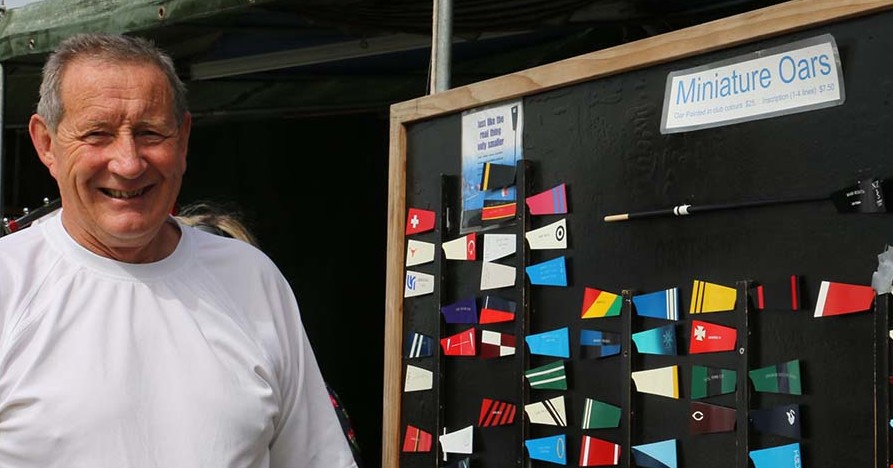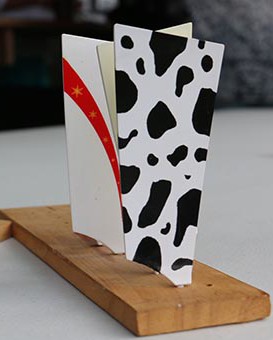The pursuit of oarthenticity
One man at Karapiro spends an awful lot of time on the oars – but never rows a stroke.

At least one person at Maadi did n0t mind the wet weather yesterday.
Rowing enthusiast Rob McCarthy runs a stall, selling “oarthentic” miniature oars, and finds a little rain helps his display look its best.
“It’s actually brilliant because the automotive lacquer, that every blade is painted with, just shines up and [the miniatures] look like brand new again,” he said.
Every year since 2003 McCarthy has sold hand-painted and personalised miniatures at Maadi, building up a stock of replicas in each school’s colours before the regatta starts. On top of individual orders he donates replicas to the regatta as awards for assistant of the day, coxswain of the day, and rower of the day.
McCarthy said the stall’s roots go back to the rowing world championship at Lake Karapiro in 1978. That year McCarthy made 50 replica oars that were given to the event’s champions.
Back then McCarthy would carve the miniatures from timber.
He would painstakingly sand them down to a smooth finish. Next, he would infuse each piece with his love of rowing. He would keep at it even as the sandpaper rasped away at his fingertips until they bled. And then he would carefully paint the tiny oar blade in the colours of a school or rowing club, precisely matching the pattern to scale. Finally, he would glazing it with automotive lacquer.
“Now they’re all plastic extruded, so they’re all identical,” McCarthy said.
“I get them done in nine different colours, this one for example started out as red,” he said pointing to a black oar with two red vertical stripes. “Then I just masked up the red and sprayed on the black. That actually helps, it saves a lot of painting. That’s where most of the work is.”
But even as he embraces new technology he remains dedicated to craftsmanship.
Some other replica oar makers are turning to stickers to get the tricky detailing of club logos right.
That’s not for McCarthy.
He thinks they just don’t look as good as the traditional painted logos.
Stickers can peel or flake, and they’re a little too precise and consistent to be unique.
“It starts to look a bit false really…[I want] to keep that traditional look of it.” he said.
McCarthy started the stall at Maadi because he wanted to share his passion with rowers and fellow enthusiasts.
“I used to only make them for people who’d won a medal or a title…then I realised ‘wow people really love this simple little thing’,” he said.
Because of the enthusiastic reactions McCarthy decided people should not have to win to get one.
He felt people should be able to buy the miniatures just to put them up to show they love the sport.
He tries to keep it affordable enough so anyone at Maadi can own one.
He has only put his prices up once, five years ago, and will hold to $25 an oar for as long as he can afford to.
Parent Anne Kirk thought the miniatures were a great idea.
She ordered a personalised, and engraved mini-oar in Christchurch Girls High colours for her daughter Maddy Thomas who is representing the school at Maadi.
“It’s something different than the usual t-shirts and things, something nice to put up on her wall,” she said
Her husband, Roger Kirk, admired McCarthy’s workmanship. He said it was good to see quality when events like Maadi often attract a lot of poorly made “gypsy stuff”.

Proud parents of Maadi competitors aren’t the only ones who appreciate McCarthy’s miniatures.
McCarthy’s Auckland based company, Oarthentic Oars, is starting to see more and more international orders through its website.
He’s had orders for oar blades from Chicago and Texas Universities, and for national teams from the UK, Canada, Sweden and Turkey among others.
But the one he’s proudest of, one of the most challenging replicas he’s made, is patterned after a cow.
A Holstein cow to be exact, the ones with the black and white patches. Apparently, no two have the same pattern.
He first came across it right at the beginning, when he’d just started to make replica oars.
He was looking through club colours and patterns from around the world when he saw it, the oar of Middlebury College, an American university.
He took one look at the cow patterned oar and thought “How am I going to paint that?”
It wasn’t enough for McCarthy to get a similar pattern. It was supposed to be a replica, it needed to be the exact same pattern. Only tiny.
He was stumped.
He worked at it, off and on, trying to get that splotch with the little bit sticking out just right. Figuring out how to make that blob that scaled down to a small dot have the right curve.
Then after three years he cracked it. It was a replica, the pattern was exactly right, only tiny.




